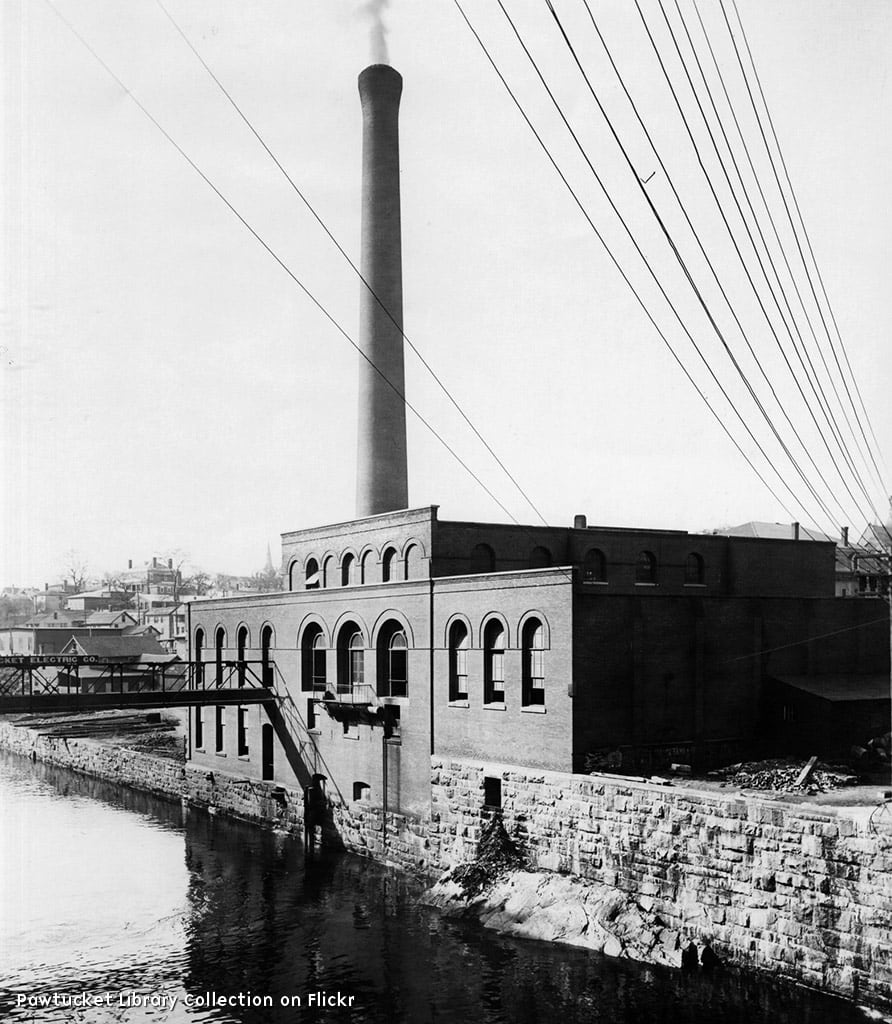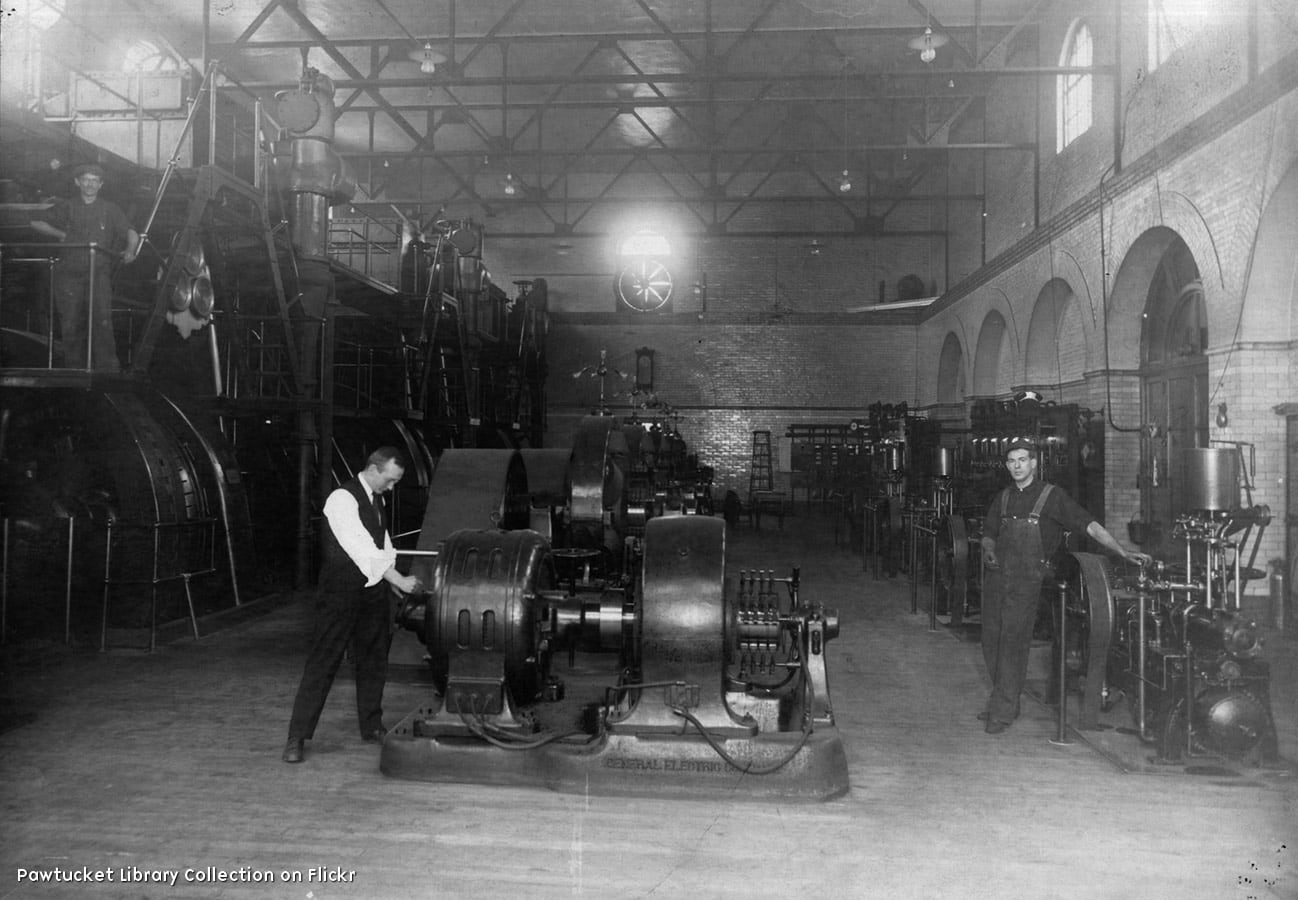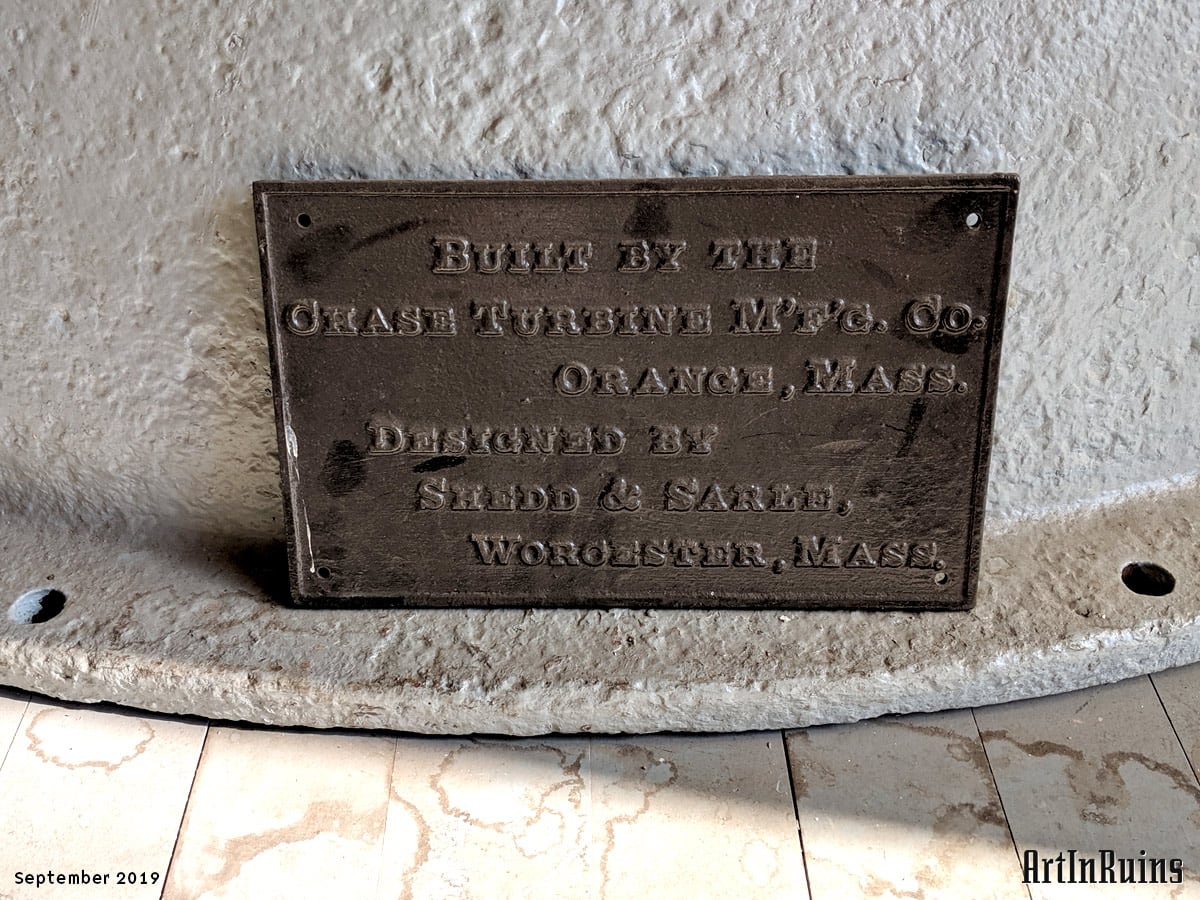Bridge Mill Power Plant
A fine example of turn-of-the-19th-century hydroelectric power generation situated below Pawtucket Falls along the Blackstone River
images of this Property
-

1912 exterior, Pawtucket Library Collection on Flickr -

1912 exterior, Pawtucket Library Collection on Flickr -

Looking north northeast from Roosevelt Avenue. Photo by Warren Jagger for the National Register Nomination form, 1981 -

Looking northwest from the opposite river bank. Photo by Warren Jagger for the National Register Nomination form, 1981 -
![]()
Looking south southeast along Roosevelt Avenue -
![]()
-
![]()
Plaque from the Preservation Society of Pawtucket, reading “Bridge Mill Power Plant • Built 1894” -
![]()
View north northeast from Roosevelt Avenue -
![]()
Detail of the southwestern corner. Notice the bricked in half-round windows along the southern façade (to the right in the photo) -
![]()
Straight-on view of the southern façade, looking north -
![]()
Detail view of the waterfall under the Main Street bridge from the backside of the power plant -
![]()
View looking southwest from the opposite river bank via the Main Street bridge -
![]()
View of the western façade and entrance. A steel walkway rises over a basement. The wide entrance has sidelights and a lovely half-round window above. Above this, on the second floor, is another smaller half-round window over a rectangular window base. -
![]()
Peering inside from the entrance door -
![]()
One of the old turbines on display -
![]()
Plaque associated with the previous turbine, reading “Built by the Chase M’f’g. Co. Orange, Mass., Designed by Shedd & Sarle, Worcester, Mass.” -
![]()
View across the floor towards the entrance of machinery on display -
![]()
Detail of one of the turbines, labelled “General Electric Company” -
![]()
View of the Lombard Governor -
![]()
Plaque associated with the previous governor, reading “The Lombard Governor Co. — Ashland, Mass. U.S.A. — Type C No. 64” with associated dates for patents -
![]()
A bank of old electric meters
21 images: Press to view larger or scroll sideways to see more. Contributions from the Pawtucket Library Collection on Flickr and Warren Jagger
About this Property
Redevelopment
This hydro plant was elected to the “Hydro Hall of Fame” in September of 1996, in only the second year of induction. Decommissioned in 1971, it became cost-effective to spin the plant back up starting with the 1973 oil embargo. In 1980, Blackstone Valley Electric announced plans for an extensive rehabilitation project. They began in 1983 and finished in 1985. The plant now has a capacity of 1.7 MegaWatts and an annual generation of around 7,200 megawatt-hours.1
The Bridge Mill Power Museum opened after its 100th anniversary, in May of 1996. The museum is open rarely these days and was last open during Doors Open RI in 2019.
Current Events
Bridge Mill Power Plant was acquired by Gravity Renewables in 2014 and added to its portfolio of hydropower facilities across New England.2 Over 600 homes are still powered by the falls today.
History
The Pawtucket Library Flickr collection has 40 images (some of them duplicates) of the Bridge Mill Power Plant, a few even while under construction.
Excerpt from the National Register Nomination form, 1983
Significance
The Bridge Mill Power Plant is one of the earliest surviving electric-power generating plants in Rhode Island, with its hydraulic system in and much of its original equipment intact. Architecturally, the plant is perhaps the finest nineteenth-century example of this building type remaining in Rhode island.
In the mid-1880s, members of the Goff family of Pawtucket began buying up the various small lots and the much-divided water privileges on the western side of Pawtucket Falls. Ownership of a large chunk of property here, both land and water rights, was finally consolidated by the Goffs in 1893 and the development oF the Bridge Mill Power Plant on this site was immediately begun. The electric-generating plant, however, was only one part of a much grander overall development plan. The Goffs’ original intention was to build a new, 700’ long street through their newly acquired property, to erect a whole range of new, commercial and light manufacturing buildings along this street, and to construct other larger buildings for heavy manufacturing closer to the riverfront, with power for all of the myriad operations planned for these new buildings to be provided by means of electric motors driven by the Goff’s new power p1ant. That p1ant, however, appears to have been the only portion of this grand scheme to materialize. Shortly after its completion, the Goff-owned Bridge Mill Power Company which had built it, was merged into the Pawtucket Electric Lighting Company (owned by the Pawtucket Gas Company) to form the new Pawtucket Electric Company. The electricity generated by the new water-powered station was then used to augment the production of the Electric Lighting Company’s older, steam-fired plant located a half-mile further south. […]
From “RHODE ISLAND: An Inventory of Historic Engineering and Industrial Sites”, Gary Kulik and Julia C. Bonham, 1978
Bridge Mill Power Plant 1893-1894 Main Street at Southwest corner of Main Street Bridge Pawtucket. This electric power plant, built in 1893-1894, could be powered by either steam or water. The building is brick, two-to-three stories high, with round-arch windows. The firm of Shedd & Sarle of Providence was responsible for the site’s hydraulic engineering. They constructed a [the] Pawtucket Falls Dam and an underground conduit, 130’ X 17 1⁄2’, both of brick. Everson and Liddle of Providence constructed the granite retaining wall at river’s edge while Stone, Carpenter, and Willson of Providence designed the flat-roofed gate, power, and boiler houses. The five pairs of 33-inch McCormick turbines-still in place — though one has a broken shaft — were installed by the Rodney Hunt Machine Company of Orange, Massachusetts as were the flumes which measure ten feet in diameter and thirty feet in length. The turbines operated with seventeen feet of head and produced 1300 horsepower. Five Lombard governors also remain in place. The plant’s steam power generation came from two Westinghouse compound automatic engines, with cylinders of 15 inches and 27 inches respectively and 16 inch strokes. Two Heine water tube boilers provided the steam. Both the engines and boilers have been removed. Electricity was last generated here in the l960s.
From the RIHPHC survey of Pawtucket, 1978
Bridge Mill Power Plant 1893-1894; Stone, Carpenter & Willson, architects; hydraulic and masonry engineering by Shedd & Sarle; water wheels, flumes and transmission equipment installed by Rodney Hunt Machine Company. 2-and 3- story, brick, electric-power generating plant. Flat roofs, round-head windows many now bricked in. Built for the Pawtucket Electric Company. Could be powered by water through five pairs of 33-inch McCormick turbines still in place or by steam through two Westinghouse compound automatic engines provided with steam from two Heine water tube boilers (engines and boilers removed). Probably the finest l9th-century electric-power generating plant extant in Rhode Island.
-
“Hydro Hall of Fame: Honoring the Foundations of Hydropower,” Hydro Review, September 1996. Captured April 16, 2022 from https://images.hydroreview.com/wp-content/uploads/2017/08/Hydrohalloffame.pdf ↩
-
“Gravity Renewables Announces Addition of Rhode Island Hydroelectric Facility,” April 25, 2014. Captured April 16, 2022 from https://www.gravityrenewables.com/gravity-renewables-announces-addition-of-rhode-island-small-hydro-hydroelectric-facility/ ↩
















